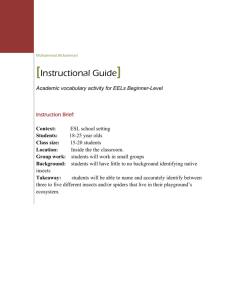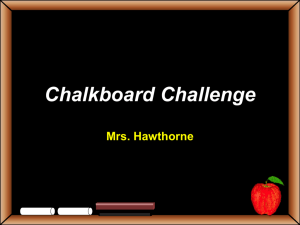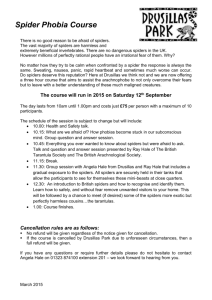Description of the child
advertisement
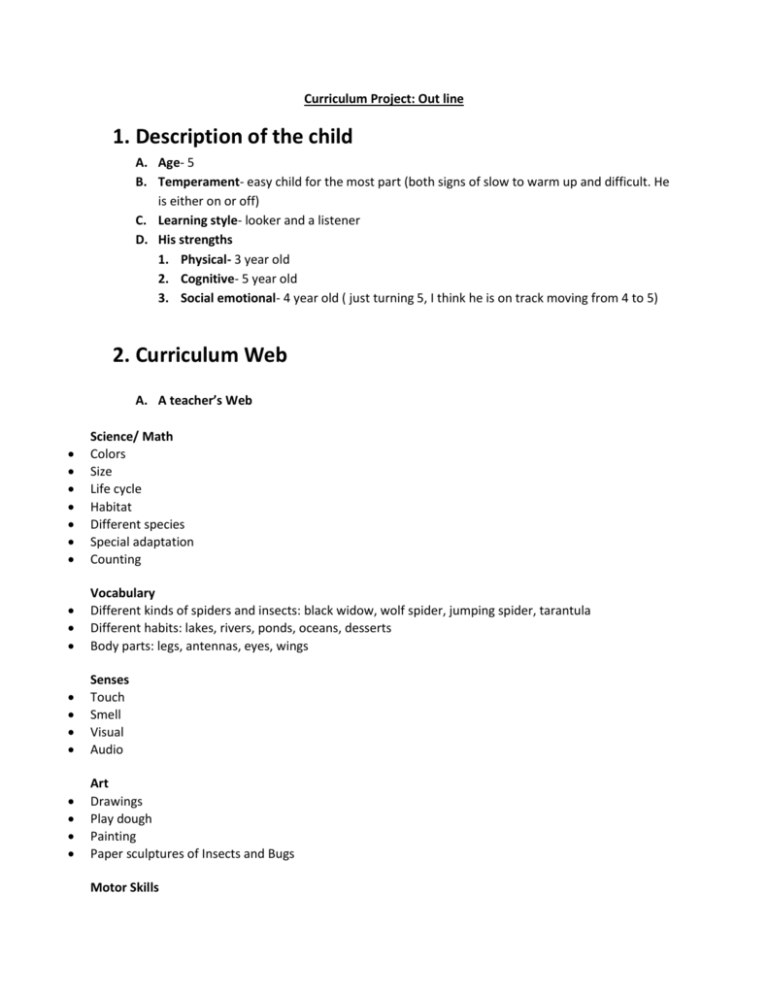
Curriculum Project: Out line 1. Description of the child A. Age- 5 B. Temperament- easy child for the most part (both signs of slow to warm up and difficult. He is either on or off) C. Learning style- looker and a listener D. His strengths 1. Physical- 3 year old 2. Cognitive- 5 year old 3. Social emotional- 4 year old ( just turning 5, I think he is on track moving from 4 to 5) 2. Curriculum Web A. A teacher’s Web Science/ Math Colors Size Life cycle Habitat Different species Special adaptation Counting Vocabulary Different kinds of spiders and insects: black widow, wolf spider, jumping spider, tarantula Different habits: lakes, rivers, ponds, oceans, desserts Body parts: legs, antennas, eyes, wings Senses Touch Smell Visual Audio Art Drawings Play dough Painting Paper sculptures of Insects and Bugs Motor Skills Looking at bugs with magnifying glasses Painting Looking for insects and spiders B. A web of possible activities Art Paint: different habitats Make play dough insects and bugs Egg carton spiders Draw insects and bugs Collage: of different insects and bugs, of different habitats, different kinds of thing they eat Dramatic Play Finger play: Itsy Bitsy Little Spider Predators and prey Build Habitat Insect and spider puzzle Yarn spider webs Books Miss spider’s Tea Party By: David Kirk Bug Safari By: Bob Barner Insects and Spiders Encyclopedia of the Animal World National Audubon society field Guide to North American Insects and spiders Take Field Trips Zoo (San Francisco and Oakland) Lindsay Wildlife Museum Different habitats: Moss beach (tied pools), Mt. Diablo (streams), and Lake Barresi (lake). C. A web to consider potential learning Vocabulary Different kinds of spiders and insects: field cricket, eastern Dobsonfly, house mosquito, Carolina wolf spider Different habits: lakes, rivers, pounds, oceans, desserts, houses Body parts: jointed legs, abdomen, thorax, compound eye, simple eye, eggs ` Creativity Yarn spider webs Making Collages Dramatic play Singing/ moving Making a habitat in the classroom Senses touch Smell Visual Audio Science/math Life cycle Habitat Colors Size Different species Special adaptation Counting Fine/Gross Motor skills Painting Cutting Using a magnifying glass Moving in different habitats on flied trips Moving like different insects and bugs (example: crawling like a spider) Social Skills Going on field trips reading books in groups Playing predator and prey 3. Project Approach Possible Plan 1. Project approach concept- Because he is all reading the same book about insects and spiders 2. A. Provision1. Bug land 2. More books about spiders and insects 3. Toy insects and spiders 4. Different bug costumes and bug parts: wings, antennas B. Sustain: 1. Different toy spiders: use at circle time, have them name the spiders, and then hide them with a towel then lift it up, and have one missing. Have the kids name which one is missing 2. Get a bug or insect for the class room 3. Magnifying glasses and nets (things that kids could use to explore and look for bugs and insects in the yard or pretend to) 4. Yarn, for the kids to make spider webs underneath the tables. 5. Enrich: 1. There are so small, how to do they survive- what else lives with bugs: Food chain (predators and pray) 2. What purpose do insects and spiders serve: ecosystems 6. Represent: -drawings -picture -have adults quote the children -make a habitat of a spider or insect in the class 3. Flied trip: - Zoo: to see lots of different kinds of bugs and insects (Oakland and San Francisco) - Lindsay Wildlife Museum - Different habits: Moss Beach (tied pools), Mt. Diablo (streams), and Barresi Lake (lake). 4. Expert- Someone from the zoo, who works in the Insect and spider areas. And also an interpretive guide from the Lindsay Wildlife Museum. 5. Closing event- Have the parents come see the habitat the kids set up, and have them show their parents all the different animals and things that happen in the habitat.
